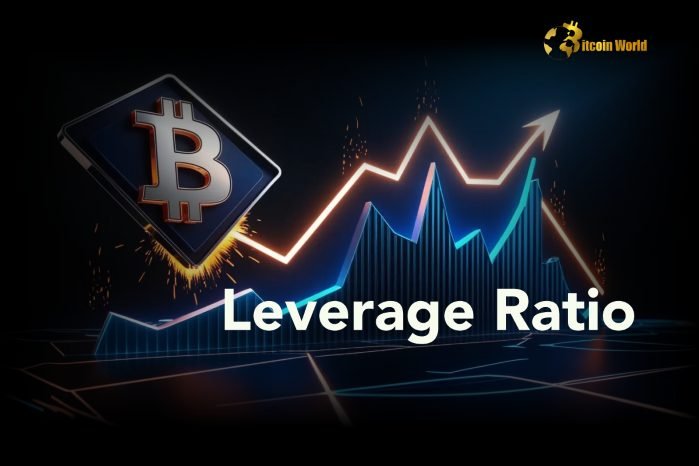Bitcoin’s Leverage Ratio Hits Two-Year High, Indicating Possible Correction Ahead
According to recent data shared by crypto insights platform Satoshi Club (@esatoshiclub) using analysis from IntoTheBlock, Bitcoin’s leverage ratio has surged to levels not seen since the collapse of the FTX exchange. This high leverage ratio indicates an elevated level of open interest in Bitcoin perpetual swaps relative to its market cap, a scenario that could potentially precede a market correction. High leverage in cryptocurrency markets often signals heightened volatility, as leveraged positions can lead to rapid price swings when the market shifts.
This article will explore the implications of Bitcoin’s high leverage ratio, examine historical precedents, and provide insights into what investors should watch for in the coming weeks.
Understanding Bitcoin’s Leverage Ratio
The leverage ratio in Bitcoin trading is a measure of the amount of open interest in perpetual futures or swap contracts relative to the asset’s market capitalization. In simple terms, it shows how much borrowed capital (leverage) is being used to trade Bitcoin compared to its overall market size.
A high leverage ratio often means that more traders are betting on Bitcoin with borrowed money. While this can amplify returns in a favorable market, it also increases the risk of forced liquidations and price corrections if market sentiment shifts.
How the Leverage Ratio Works in Bitcoin Trading
Leverage allows traders to control larger positions with a smaller amount of capital, aiming for potentially higher returns. However, this approach also increases the risk of substantial losses. When leverage reaches high levels, even small price changes can trigger mass liquidations, leading to a “deleveraging” event that rapidly drives prices down.
As of recent data, Bitcoin’s leverage ratio has reached a two-year high, signaling an intense level of risk-taking in the market. This spike suggests that more traders are heavily leveraged in their positions, which, based on previous patterns, could lead to heightened volatility and a potential market correction.
Historical Context: Leverage Ratio Patterns in Bitcoin
Historically, high leverage ratios have been followed by significant price corrections in Bitcoin, often as a result of market-wide deleveraging. For instance, in May 2021, a similar leverage spike was observed before Bitcoin’s price plunged from its then-high of around $64,000 to nearly $30,000. In these situations, cascading liquidations often exacerbate price declines, leading to further sell-offs.
Notable High-Leverage Events in Bitcoin’s History
May 2021: Bitcoin’s leverage ratio reached extreme levels, followed by a steep correction that cut its price nearly in half. The correction was intensified by liquidations across leveraged positions, which forced traders to sell and caused further downward pressure.
November 2022 (FTX Collapse): The collapse of FTX led to a market-wide reduction in leverage as investor confidence plummeted. Bitcoin’s price saw significant volatility as leveraged positions were quickly unwound, dropping from around $21,000 to under $16,000.
Current Situation (2023): The leverage ratio is now approaching these historic highs again, raising questions about whether another correction may be imminent.
Why a High Leverage Ratio Signals Possible Price Correction
The high leverage ratio in Bitcoin indicates that traders are highly optimistic about price increases. However, this optimism can lead to a market imbalance. When prices start to decline, these leveraged positions become vulnerable to liquidations, which can create a domino effect as traders rush to cover their positions, accelerating the downturn.
Key Factors Contributing to a Potential Correction
Market Sentiment: High leverage levels often signify that the market is overly optimistic, a condition that has historically led to corrections. As sentiment shifts, a sell-off can quickly trigger mass liquidations.
Volatility in Crypto Markets: The crypto market is highly sensitive to sentiment changes, and Bitcoin’s price has proven to be no exception. With increased leverage, the potential for rapid price changes also rises.
Broader Economic Conditions: Global economic factors, such as interest rates, inflation, and regulatory developments, also affect the crypto market. Sudden economic shifts can trigger a flight to safety, pushing traders to liquidate their high-risk positions.
How High Leverage Impacts Bitcoin’s Price
When a large percentage of open interest in Bitcoin perpetual swaps is tied up in leveraged positions, even a slight decline in price can trigger a wave of forced liquidations. This effect compounds during times of high leverage, as each liquidation causes further price declines, which then lead to additional liquidations. This phenomenon is known as a “liquidation cascade.”
The Role of Forced Liquidations in Price Movements
Forced liquidations occur when traders using leverage cannot meet margin requirements, leading to the automatic closing of their positions. This process leads to a rapid sell-off, driving prices down and often creating short-term volatility. In times of high leverage, these cascades can intensify market corrections as stop-loss orders and automated trading programs contribute to selling pressure.
Implications for Bitcoin Investors: What to Watch For
Given the high leverage ratio, investors should prepare for potential volatility. While not every high-leverage scenario results in a major correction, Bitcoin’s historical patterns indicate that extreme leverage often precedes price swings.
1. Monitor the Leverage Ratio and Open Interest
Investors should keep an eye on both the leverage ratio and the total open interest in Bitcoin perpetual swaps. If open interest continues to grow along with leverage, the likelihood of a correction increases as more traders will be at risk of liquidation.
2. Look for Signs of a Sentiment Shift
A sudden change in market sentiment—whether from a regulatory development, macroeconomic shift, or large sell-off—could trigger a cascade of liquidations in the high-leverage environment. Monitoring news, social media trends, and market sentiment can provide early warning signs of a potential downturn.
3. Consider Reducing Exposure or Setting Stop-Loss Orders
Investors may wish to reduce exposure in highly leveraged environments or set stop-loss orders to minimize potential losses. For those holding long-term Bitcoin positions, diversification can help mitigate the effects of a possible market correction.
4. Prepare for Volatility
With high leverage comes high risk. Investors should be prepared for increased volatility in the coming weeks as leveraged positions continue to influence Bitcoin’s price dynamics. Staying alert to price movements and remaining disciplined in trading strategies can help manage risks during potentially volatile periods.
Will Bitcoin’s High Leverage Ratio Lead to a Correction?
While the high leverage ratio does not guarantee a correction, it increases the chances of volatility in the near term. If Bitcoin’s price begins to decline, the large number of leveraged positions could create a feedback loop of liquidations and sell-offs, leading to a sharper drop in price.
However, if market sentiment remains strong, it’s possible that leveraged traders may hold onto their positions, postponing a correction. In this case, Bitcoin’s price may continue its upward trend until a major market shift occurs. Ultimately, the outcome will depend on a complex combination of market sentiment, investor behavior, and broader economic conditions.
Conclusion: A Cautious Outlook Amid High Leverage
Bitcoin’s current high leverage ratio signals a market with significant risk, and investors should remain vigilant in the days and weeks ahead. Historical data suggests that Bitcoin often experiences corrections following periods of extreme leverage, as evidenced in 2021 and during the FTX collapse. However, while a correction may be on the horizon, it’s not a certainty.
By monitoring key metrics, staying informed on market sentiment, and implementing appropriate risk management strategies, investors can navigate the potential volatility that may accompany Bitcoin’s high leverage. Whether this period leads to a correction or continued growth, caution remains essential.
To learn more about the innovative startups shaping the future of the crypto industry, explore our article on latest news, where we delve into the most promising ventures and their potential to disrupt traditional industries.





